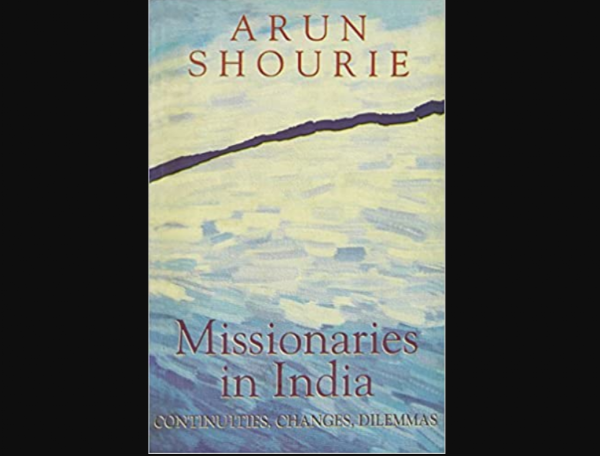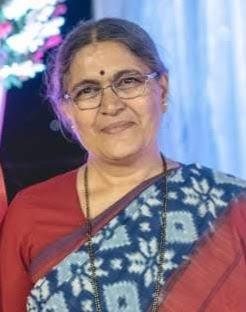INSIGHT XIX: Reality of Christian missionaries through the lens of Arun Shourie's book
Namaskar, the new series "INSIGHT" is an attempt to present the central thought of a thought-provoking book. "Missionaries In India Continuities, Changes, Dilemmas", a book by Shri Arun Shourie compels readers to contemplate various points put forth.
Total Views |
In August 1853 the objective was the conversion of children and in 1952 January schools were seen to be meant for the expansion of the Kingdom ( Kingdom of Christ).
In March 1954 medicine and education were treated to be the effective means of conversion. Schools were used to spread Christianity. It is treated to be the duty of a teacher ' that the word of Christ should take root and flower in the students '. ( Reference church publication Gharbandhu in March 1953 ) It is recorded that children then knew the ten commandments, prayers, old and new testaments, songs, and hymns. So it was expected that when they would grow they would accept Christ. It was observed that the Munda religion too did not object to these activities, on the contrary the village took the responsibility of looking after the teacher. ( Of the schools opened by Church).

The author notes that from the 16'th century the Church focused on Harijans and tribals. Richard Temple stated clearly that the aborigines' minds and consciences were like a clean slate, missionaries could make a mark. He had a very clear idea that education should be followed by the propagation of Christianity. The same thread runs through a century and even in 1994 too it is reiterated. The focus did not change a bit. During British rule, this was facilitated by the government.
The design was very explicit, first the notion was circulated that they were not part of Hindu society. Leaders from the community or from outside, who strengthened the theory were patronized and encouraged to further the notion of separateness. A set of benefits were offered to them only on detaching themselves from the rest of the Hindu society. And the government ( British ) too helped in this mission.
Tribals were declared to be Animists, not Hindus. Of course, tribals did not understand this, but the officials and missionaries defined their lifestyle and cut them off from Hindus. Basically, their life style and practices were a variety of Hindus. But this was not accepted. The name of the tribe was entered in the column of religion when data for census was collected.
Of course the officials were aware that the concept of religion is not applicable to Hinduism,it has a comprehensive concept of ' Dharma '. Thus it was left to the whims of enumerators.
The word Animism was replaced by ' tribal religion ' and they were many in number. The problem was many tribals used the label Hindu to fill the column of religion.
There was always an attempt to show tribes they had separate identities. ( Not a part of the Hindu fold. ). Enumerators were not convinced, thus all the tribes were not labeled as different from Hinduism. Some groups like Satnamis, Kabirpanthis, Arya, and Brahmo samajis were excluded from Hinduism but this too did not succeed. All wanted to be labeled as Hindus despite the efforts of the administration.
Even in 1992, the report on dislocated people accepted the fact that though tribals and Hindus had their deities different from each other, there were signs of Hindu influence. The same strategy was adopted to show Sikhs are different from Hindus. The separateness was instilled consciously.
1906 was the year when a memorandum was submitted demanding separate electorates for Muslims. This the author described as an engineered effort. Acceptance of the demands was viewed as something that would culminate in the partition of India.
This was followed by leaders of Harijans' demand for separate electorates. It was granted. Gandhi Ji could see what the British were aiming at, so he resisted it with the fast-unto-death in 1932. Though the decision changed, the issue and the long lasting effect of distrust and unrest still persists. The seed was sown with a notion and we experience it even in the present scenario.
In March 1954 medicine and education were treated to be the effective means of conversion. Schools were used to spread Christianity. It is treated to be the duty of a teacher ' that the word of Christ should take root and flower in the students '. ( Reference church publication Gharbandhu in March 1953 ) It is recorded that children then knew the ten commandments, prayers, old and new testaments, songs, and hymns. So it was expected that when they would grow they would accept Christ. It was observed that the Munda religion too did not object to these activities, on the contrary the village took the responsibility of looking after the teacher. ( Of the schools opened by Church).

It is observed by Verrier Elwin in 1944 that fathers were 'proselytizing on an unprecedented scale ', and the methods they followed were ' disgraceful ' even by middle ages standards. They interfered with the work of courts and local officials too to give the gonds the impression that they were real power or sirkar. Fathers had money lending business which was an effective means to control gonds and force them into Church. ( Verrier Elwin, 1902 - 1964, was a British Missionary, who later adopted a mixed lifestyle, became an Indian citizen, stayed in India till his death, was known to be an expert on tribal lifestyle,was awarded Padma Bhushan, worked in many positions for the government of India, some considered him to be a pretender to anthropological science)
The design was very explicit, first the notion was circulated that they were not part of Hindu society. Leaders from the community or from outside, who strengthened the theory were patronized and encouraged to further the notion of separateness. A set of benefits were offered to them only on detaching themselves from the rest of the Hindu society. And the government ( British ) too helped in this mission.
Tribals were declared to be Animists, not Hindus. Of course, tribals did not understand this, but the officials and missionaries defined their lifestyle and cut them off from Hindus. Basically, their life style and practices were a variety of Hindus. But this was not accepted. The name of the tribe was entered in the column of religion when data for census was collected.
Of course the officials were aware that the concept of religion is not applicable to Hinduism,it has a comprehensive concept of ' Dharma '. Thus it was left to the whims of enumerators.
The word Animism was replaced by ' tribal religion ' and they were many in number. The problem was many tribals used the label Hindu to fill the column of religion.
There was always an attempt to show tribes they had separate identities. ( Not a part of the Hindu fold. ). Enumerators were not convinced, thus all the tribes were not labeled as different from Hinduism. Some groups like Satnamis, Kabirpanthis, Arya, and Brahmo samajis were excluded from Hinduism but this too did not succeed. All wanted to be labeled as Hindus despite the efforts of the administration.
Even in 1992, the report on dislocated people accepted the fact that though tribals and Hindus had their deities different from each other, there were signs of Hindu influence. The same strategy was adopted to show Sikhs are different from Hindus. The separateness was instilled consciously.
1906 was the year when a memorandum was submitted demanding separate electorates for Muslims. This the author described as an engineered effort. Acceptance of the demands was viewed as something that would culminate in the partition of India.
This was followed by leaders of Harijans' demand for separate electorates. It was granted. Gandhi Ji could see what the British were aiming at, so he resisted it with the fast-unto-death in 1932. Though the decision changed, the issue and the long lasting effect of distrust and unrest still persists. The seed was sown with a notion and we experience it even in the present scenario.


